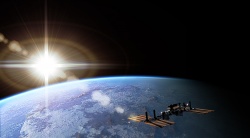Microbes on the International Space Station
Do microbes grow differently on the International Space Station than they do on Earth? Results from the growth of microbes collected by citizen scientists in Project MERCCURI indicate that most behave similarly in both places.

"While this data is extremely preliminary, it is potentially encouraging for long-term manned spaceflight," said David Coil, Ppoject scientist in the microbiology lab of Jonathan Eisen at the University of California, Davis.
"With this part of Project MERCCURI we hoped to shed light on how microbes associated with the normal, human and built environment behaved in space. Our focus was not on microbes that cause disease, but the many beneficial and neutral microbes that surround us on a daily basis," he said.
Thousands of people across the country participated in the citizen science portion of the project, gathering samples from built environments such as chairs, doors, railings... even the Liberty Bell. Then the microbiology team in the UC Davis lab grew and examined hundreds of microbes. The team selected 48 microbes which, with approval from NASA, rode the SpaceX Falcon 9 to the Space Station for further research. Of those 48, only a handful grew at all differently in Space, and the difference was significant for only one: Bacillus safensis. This microbe was collected on a Mars Exploration Rover (before it was launched) at the NASA Jet Propulsion Laboratory in Southern California. It grew significantly better on the Space Station.
"We observed that the vast majority of the microbes we examined behaved the same on the Space Station as they do on Earth. In the few cases where we observed a microbe behaving differently in space than on Earth, we'd love to follow that up with further experiments," Coil said.
In addition to comparing growth rates on Earth and the Space Station, UC Davis identified winners in three different categories for the "Microbial Playoffs" in space.
Best Huddle: the microbe that grew to the highest density, packing cells into the space allowed
- Yuri's Night, Los Angeles: Kocuria rhizophila was collected on a camera at a Yuri's Night Party with Buzz Aldrin, the second person to walk on the moon.
- San Antonio Spurs: Kocuria kristinae was collected on the court after a San Antonio Spurs game.
- Discover Magazine: Micrococcus yunnanensis, collected from a dictionary at theDiscover Magazine offices.
Best Tipoff: the microbial competitor that took off, growing like crazy from the start
- Pop Warner Chittenango: Bacillus pumilus was collected on a Porta-Potty handle by Pop Warner Chittenango Bears cheerleaders.
- Smithsonian Air & Space Museum: Pantoea eucrina was collected on the Mercury Orbitor at the Smithsonian Museum of Air and Space.
- Pop Warner Saints: Bacillus horikoshii was collected on a football field by Pop Warner Saints cheerleaders from Port Reading, NJ.
Best Sprint: the microbe that grew the fastest during the sprinting portion of growth (technically known as the "exponential growth phase")
- Oakland Raiders: Bacillus aryabhatti, collected on an Oakland Raiders' practice football field
- Pop Warner Chittenango: Bacillus pumilus was collected on a Porta-Potty handle by Pop Warner Chittenango Bears cheerleaders.
- Mars Exploration Rover (JPL): Paenibacillus elgii, collected from a Mars Exploration Rover before launch (2004) at the Jet Propulsion Laboratory (JPL- NASA, Pasadena, CA).
Find rankings of all 48 samples in these three growth categories on the Results page at the Space Microbes web site.
Other elements of Project MERCCURI are still in process. In addition to overseeing the microbial playoffs, astronauts also collected microbes on the Space Station and sent those back to Earth. The UC Davis team has analyzed the data from those and are preparing a scientific publication on the results. In addition, members of the public contributed 3,000 cell phone and shoe samples for an ongoing analysis of which microbes live where, and how that compares to the ISS.
"With this project, thousands of people contributed to research on the Space Station and at UC Davis, one of the leading microbiology research labs in the country," said Darlene Cavalier, founder of SciStarter and Science Cheerleader, which led the microbe collection effort. "Our goal is to spur even more people to get involved in significant science. Whether someone is a child or an adult, is interested in space or the ocean, in biology or chemistry, in the climate or computers - scientists are working on research and development that would benefit from more participation."
Source: University of California - Davis Health System
29.05.2015











